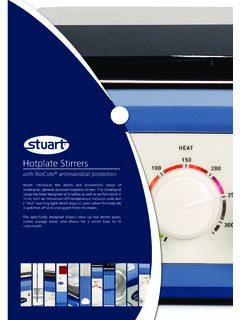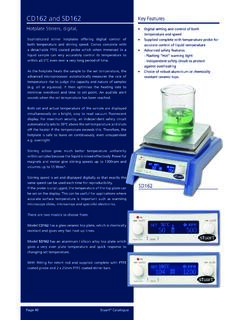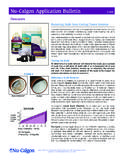Transcription of T10-001A Care and maintenance of water baths - …
1 +44 (0)1785 810433 water baths Technical note: T10-001A care and maintenance of water baths Introduction The inner containers of the Stuart water baths are manufactured from grade 304 stainless steel, a material which is extremely hardwearing, easy to clean and with excellent corrosion resistance. It is important to remember that although stainless steel has a higher resistance to oxidation than ordinary steel in various environmental conditions, it is not rust and corrosion proof. care must be taken when using the baths not to use or introduce chemicals which may cause damage to the surface of the bath . Regular cleaning and maintenance will prolong the life of the bath and enable continued use for many years.
2 bath water For the Stuart baths we recommend water , preferably distilled or deionised, with neutral pH. Ultra pure deionised or RO water with a resistivity >1 Mohm should not be used, as this can leach the iron from the stainless steel and lead to corrosion. If necessary, add a little tap water to the pure water in the bath . Hard tap water should also be avoided as this can cause build up of scale inside the bath and on the heating elements. Other salts in tap water such as chlorides and sodium ions can also lead to pitting and corrosion. maintenance For water -filled baths it is recommended that the bath is drained, cleaned and re-filled on a weekly basis to avoid build up of salts and contamination. Regularly adding fresh water will replenish the oxygen which helps maintain the protective chromium oxide layer on the stainless steel.
3 This is especially important if the water is stationary or has been boiled. baths that are used for biological applications and heated to physiological temperatures can become breeding grounds for algae, fungi and harmful bacteria. Regular heating to >60 C for 30 minutes can be used to thermally disinfect the bath before cleaning. If this is not possible, then a chemical biocide may be used. Check that the agent is suitable for use with stainless steel. Do not use bleach (sodium hypochlorite) or other chlorine based solutions as a disinfectant. Make sure the bath contains sufficient liquid to cover the heating element to avoid running the bath dry. Turn the bath off overnight and when not in use. If a bath is not to be used for some time, it should be emptied, cleaned and kept dry.
4 Cleaning In general baths should be cleaned with a mild household or laboratory detergent using a sponge or soft cloth. Scouring powders, steel wool or other abrasive pads should not be used. Scale build up can be removed using a mild household descaler and soft brush; follow the manufacturer s instructions for correct use. Rinse thoroughly after cleaning and dry the bath . In some cases small spots may be visible in the baths which resemble rust spots. In most cases these will be small ferrous particles on the surface of the bath which have oxidised causing the appearance of rust. These can usually be cleaned away using a standard stainless steel cleaner and plastic scourer. Regular cleaning will ensure the bath is maintained in an optimal condition and will continue to provide many years service.
5













